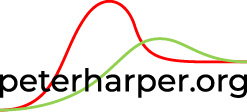The Logo, etc.
This section contains explanations of one or two features of the site some visitors might find puzzling:
Why is the domain name extension dot org and not dot com?
What is the significance of the logo pattern?
DOT ORG
A web site needs a domain name, and private sites typically use the extension ".com" or in Britain, ".co.uk". However the dot com extension suggests a commercial orientation that is not my intention. I am much more like a one-person NGO than a private enterprise. It seemed more appropriate to use ".org". And who knows, others might join me.
THE LOGO
The logo is a graphical graph. The horizontal dimension is time, the vertical dimension carbon emissions, representing all manner of other environmental impacts.
The two lines in the logo represent two contrasting development trajectories. The red line overshoots dramatically and requires an uncomfortable readjustment to get back on track. The green line represents a more rational approach to long-term sustainable flourishing, with a small but manageable overshoot. Most wealthy countries are following the red pattern. Many poorer ones still have a chance to follow the green pattern.
For the truly curious, here is a more exhaustive explanation:
THE MEANING OF THE LOGO PATTERN
The red curve represents the historical trajectory of the existing ‘developed’ world during its modernisation process. Goodness knows it was filthy, but is now cleaning up. This is less than 20% of humanity. What about the rest? If they were to mimic the same pattern the emissions and other impacts could be colossal and would almost certainly have devastating effects everywhere.
My view, for what it’s worth, is that the historical filth was accidental. We were pioneers, and just used whatever resources were available and cheap, in complete ingnorance of the consequences. Modernisation is not intrinsically filthy, and there are many ways to do it, greatly aided by improvements in technology and far greater understanding of how things work.
The green line, then, represents the other 80% of humanity, avoiding the filth generated by the pioneers and proceeding directly to a variety of sustainable pathways.
This does not mean ‘the end of history’ or the end of wars, disputes and tragedies, but it secures the physical fabric of the earth and allows humanity to ‘live to fight another day’.
The logo contrasts the two trajectories simply by putting them together:


